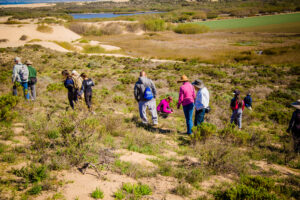Kathleen Goddard Jones Memorial Hike at Black Lake Ecological Area
July 8, 2023 @ 9:00 am - 11:00 am

 Join the Guadalupe Nipomo Dunes Center and The Land Conservancy for a hike through The Land Conservancy’s stunning Black Lake Ecological Area or Kathleen Canyon Overlook in honor of Kathleen’s Goddard Jones’ birthday on July 8, 2022. We will explore the unique Black Lake Ecological Area and enjoy the beautiful dune habitat Kathleen helped to protect. Just a short trek from the parking area to the lake and back, the trail spans 1.5 miles round-trip and goes through moderately steep hills and dunes and some uneven ground. It is only accessible by the public via guided hikes by Land Conservancy staff, making it a treat to be able to walk onto this pristine piece of land that Kathleen worked so hard to preserve for almost thirty years! Thank you, Kathleen.
Join the Guadalupe Nipomo Dunes Center and The Land Conservancy for a hike through The Land Conservancy’s stunning Black Lake Ecological Area or Kathleen Canyon Overlook in honor of Kathleen’s Goddard Jones’ birthday on July 8, 2022. We will explore the unique Black Lake Ecological Area and enjoy the beautiful dune habitat Kathleen helped to protect. Just a short trek from the parking area to the lake and back, the trail spans 1.5 miles round-trip and goes through moderately steep hills and dunes and some uneven ground. It is only accessible by the public via guided hikes by Land Conservancy staff, making it a treat to be able to walk onto this pristine piece of land that Kathleen worked so hard to preserve for almost thirty years! Thank you, Kathleen.
Bring a jack, water, and maybe even your Dune Mother Guide!
Our hike reservation is now full! Email us today if you would like to get on the wait list.
For more information on this area please visit : The Land Conservancy (lcslo.org).
About Kathleen
Kathleen Goddard Jones led a campaign that helped to preserve the largest undisturbed dune complex in the country. She was an active participant in organizations such as the Nature Conservancy, the Wilderness Society, the Audubon Society, and the California Native Plant Society. Her dedication to keep the dunes available for people to visit and appreciate its natural beauty and importance is as important as ever. In honor of this iconic figure in environmentalism, we are hosting a hike at the Black Lake Ecological Area to pay homage to Kathleen.
About Black Lake
Black Lake Parcel D is a 160 acre parcel purchased in fee in 1996 by the California State Coastal Conservancy and then transferred to the Land Conservancy in 2000. A parking easement is held with Dune Lakes Ltd.
Black Lake lies at the terminus of Black Lake Canyon on the Nipomo Mesa. The name “Black Lake” is derived from the dark color, which the lake has developed as a result of thousands of years of oak leaves and other organic matter leaching into the water, similar to tea leaves steeping in a pot of tea. The deepest part of Black Lake is approximately 8ft, but historically the water level was higher and the lake may have been as deep as 30 ft. Remnant lakes such as Black Lake and the surrounding dune lakes are evidence that a large number of lakes existed in this area long ago along with a high water table and lush vegetation.
Interesting Facts
Black Lake Canyon is approximately 4 miles long, and begins just east of Pomeroy road, and terminates west of highway 1 at Black Lake
Black Lake Canyon contains the most southern peat bog in California, and provides important wetland habitat for a large variety of flora and fauna in an otherwise semi-rural developed area.
Peat Bog – “The characteristic that distinguishes peatland from other types of wetlands is its capacity to accumulate partially decomposed vegetation material, also called ‘organic matter.’ In fact, in peatlands the annual rate of biomass production is greater than the rate of decomposition.” – Tree Plantations within the context of ecological restoration of peatlands. Sandrine Hugron, Julie Bussieres and Line Rochefort 2013.
1908, Los Berros Forest Company plants Eucalyptus on the Mesa for a timber crop. Unfortunately, they planted the wrong species and the timber cracked/warped after curing.
1936, Dorothea Lange photographs Florence Owens in Nipomo waiting for her car to be repaired. This image became an iconic representation of the dust bowl.
Cryptogamic soil – Grows on the soils surface between vascular plants. Takes many years to form so don’t step on it.
Nuphar lutea polysepala (syn. Nuphar polysepala)- Western pond lily, plant species native to western North America with San Luis Obispo county nearing its southern most range. Population decline of the Western pond lily has been observed over the years at Black Lake. The cause of the population decline is unknown, but hypothesized to be decreasing water levels in Black Lake. One of two documented populations in San Luis Obispo County.
Shell Midden – Pismo Clams
Lupinus nipomensis Nipomo Lupine – First observed at Black Lake, but populations dwindled. Endemic to the Guadalupe Nipomo Dunes. Reintroduced to BLEA in 2015.
RSVP Please!

